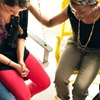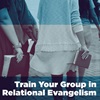People group. And affinity plays a role in how we connect. But in recent years the "affinity group" has come under attack and its viability questioned. Do such groups promote shared ignorance or exclusivity, tearing apart the fabric of biblical community? Do they promote true fellowship? Should they be replaced by diverse gatherings of men, women and children of all ages, races, languages and incomes? Isn't affinity a narrow concept?
The issue is not "affinity"—it's people. Small groups work perfectly until people show up! Let me explain what I mean—hang in there with me.
Affinity is not "exclusivity" or "likeness"—it is "commonness." It is a means of connection, not a characteristic of community. Greater affinity does not automatically produce greater community. A gathering of young mothers may experience a less true community than a more diverse group of people, but not because they are young mothers. And greater diversity does not automatically produce greater community. Just go to any college campus and watch how students group together.
Three ways most groups form
Three primary connection strategies exist today for forming groups—geography, purpose and affinity. Each serves the kingdom and contributes to God's plan for building his church. Each has biblical precedent. And churches that integrate all three will flourish.
Geography:
Old Testament tribal groupings were family-centered and geography played a significant role, particularly concerning where the tribes pitched their tents around the tabernacle (Numbers 2) and the land they would ultimately occupy (Joshua 13-22). New Testament Christ-followers gathered in homes (Acts 2:42-47; 20:20), implying some connection around places they lived.
Purpose:
In Exodus 18, groupings were influenced by the task at hand—adjudicating the disputes among Israelites. In Acts 6, seven Greek-speaking Jewish men who were full of the Spirit and wisdom were chosen to manage the distribution of food to neglected widows. Likewise, elders and deacons reflect small groups designed for a purpose—shepherding roles in the church.
Affinity:
Jesus chose a group of young Jewish Galilean males "that they might be with him and that he might send them out…" (Mark 3:14). This group was a community with a cause. But it was more than simply a short-term training group, or a serving team—it was a small group that spent much time together. It served as Jesus' primary place for modeling kingdom life and relationships yet it did not include gentiles, women, children or families, was not centered in a neighborhood, and disbanded after about 3 years.
So affinity—as one of three major entry points into small group life—plays a role in organizing people, even when a task needs to be done. But it must never be used as an excuse to promote exclusivity unless the purpose of the group so dictates (our elders, for example, is not an inclusive grouping). These affinities—drawn from a larger community or an entire congregation—can produce small group experiences that foster spiritual transformation, Christ-like compassion and achievement of mission.
I have overseen and led all kinds of groups. Presently, I lead a geographically based men's group, and have led training groups, serving groups, youth small groups, intergenerational groups, and couples groups. Each has been an experience in biblical community. But it was NOT the organizing principle that fostered community.
So what makes a group connect deeply?
I have observed that the greatest factor influencing the possibility of experiencing true community in a small group setting is what sociologists call "cohesion." Cohesion is the perceived need for a group by its members. The greater the perceived need, the greater the cohesion. And the greater the cohesion, the greater the community. Groups in Numbers 2 and Acts 6 were organized differently (one by geography and the other by purpose) but there existed a great need for each kind of group.
One Alcoholics Anonymous participant summed it up well when he said, "When I am late to church, people stare at me with frowns of disapproval as though I am not as responsible as they are. But when I am late to AA, the meeting comes to a halt, and everyone stops to hug and welcome me. They realize that my lateness may be a sign that I almost didn't make it. They understand that my desperate need for them won out over my desperate need for alcohol." Desperation drives people toward community—and keeps them there.
Christians met often in the early church because they desperately needed one another—for strength, hope, prayer, learning, and resources. How they grouped was less an issue than the true need to be together. I have been in, or visited, all kinds of groups of various sizes—neighborhood, affinity, task-based, you name it. Sadly, many lack an essential dependence on one another. It is in our poverty and weakness that we find help and hope. Community, as someone has said, begins at the edge of suffering. I agree.
Perhaps this is why you can experience a deeper level of connection in a gathering of Vietnam Veterans who have never previously met one another than in a neighborhood community of affluent suburbanites who spend their days hanging out at the tennis club. Both groups have a high level of affinity—but only one has suffered deeply and desperately needs fellow members. One experiences community; the other shares a social camaraderie. People in pain will drive many miles to gather together; people without pain, or who cannot admit they are broken, will barely drive 5 minutes to join a community. It's just not convenient. Life's too busy.
Perhaps this is why I experienced deeper fellowship among the poor and racially oppressed in South Africa than I find in suburban America where connections are often shaped by self-interest instead of brokenness and sacrifice. "Every Christian community," said Bonhoeffer, "must realize that not only the weak need the strong, but also the strong cannot exist without the weak. The elimination of the weak is the death of fellowship."
So however we find ourselves connecting—geography, purpose, or affinity—let us proclaim our dependence, desperation and weakness. It is here that we will find true community.
1. Philip Yancey, Christianity Today, June 2000, p. 73
2. Dietrich Bonhoeffer, Life Together









